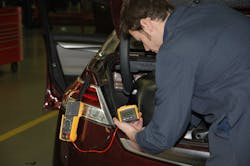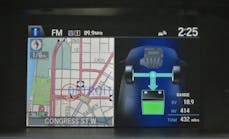In a world where technicians have equipment such as scan tools and oscilloscopes, are digital multimeters (DMMs) still necessary to have around the shop? The short answer – yes.
“DMMs are valuable in vehicle diagnostics as they allow the technician to dive deeper into the problem presented in the repair,” says Sean Silvey, product application specialist for Fluke.
The basic function of a DMM is its ability to measure voltage in numbers, explains Chad Schnitz, national sales manager at Autel U.S. This allows technicians to confirm whether they’re receiving the correct amount of voltage at a component. According to Schnitz, DMMs are also useful in finding voltage drops or differentials. Technicians can use that information to tell whether a wire can carry the voltage and/or amperage they were designed for.
Much like oscilloscopes, DMMs are best used in unison with scan tools. Scan tools can’t give technicians all the data they need, so when paired with the DMM, technicians can get enough data to figure out the next step in the repair process.
“Scan tool information is all processed data, meaning the computer consumes the information, analog or digital, and interprets what it is seeing,” Schnitz explains. “This information is always delayed and cannot display what is happening at the sensor. It can only interpret what it is seeing at the computer's connection. The DMM gives us the ability to see what is happening directly at the sensor or component. This raw data can help us determine where to go in our diagnostic process next.”
Though DMMs and oscilloscopes offer some of the same functions for diagnosing electrical systems, the biggest difference between the two is a DMM gives you more of an “average” of data, while an oscilloscope provides more “real time” data.
Independent mobile tool distributor Joel Simmons explains the difference like this: “A digital multimeter kind of takes a ‘blip’. Like a little small moment and it shows you a value, so if you have a voltage jumping around, it might register on a multimeter, [but] it looks more like a glitch. It's kind of bouncing around. An oscilloscope is more like a microscope. You can see something with your eye if you put it underneath a microscope and it shows a lot more detail. [An oscilloscope] shows you a whole pattern versus just a moment in time.”
One way technicians can begin to close the gap between oscilloscopes and DMMs is by using a graphical digital multimeter. This tool displays a graph, giving technicians a better picture of the data, as Silvey explains. However, a regular DMM just displays a numerical number for the measurement.
Regardless of the fact oscilloscopes may show technicians more data, Simmons says he still sells a lot of multimeters.
“Basically, it seems like anyone who's in any kind of automotive field right now has to have a good multimeter,” Simmons concludes. “There's not really a good way around it because there [are] so many electronics on cars.”



